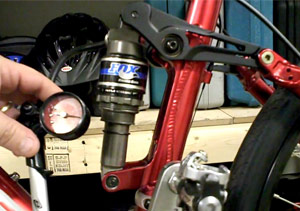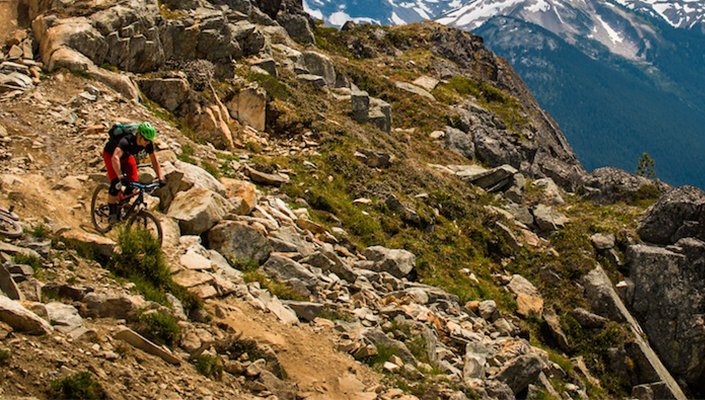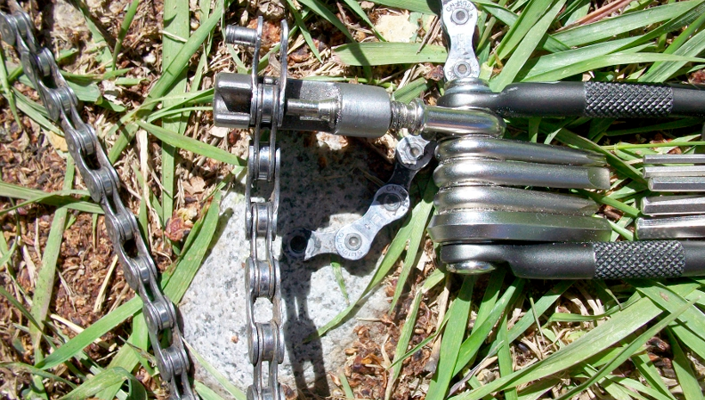Mountain biking can take you places you would never ordinarily have been, but it also has the tendency to put you in situations you would rather avoid. From medical emergencies through to mechanical faliure, there are some things you only learn the hard way. But lucky for you, we can give you some handy hints on a variety of topics, all from first-hand experience (not Google. Google does not rail berms, so we're not friends ☹).
1. MEDICAL EMERGENCIES
Learning some basic first aid is handy in any circumstance, but learning some trail specific stuff is even more useful. Did you know you can turn a Camelbak into a neck brace? Read on, and just use your imagination - again, all first-hand experiences.
Braces: Learn to turn a variety of things into an arm, leg or even neck brace. Taking a Camelbak and stuffing it with clothing before placing it around the riders' neck and clipping it closed can act as a very effective neck brace. Assess the situation, and call for help.
Splints: Finding a tree branch and using an arm warmer is all you need to make an arm or leg splint. Use the branch as a brace, and wrap the arm and leg warmers around the branch to offer support to the limb.
Location: The number one piece of information you need when riding, is your location. Where the heck are you!? Being aware of your compass and major landmarks is all it takes. Are you north of the dam, or south of the major ridge line? All of this information is critical to emergency services when your mate is suffering from shock and hypothermia. Stay calm. Think quickly. It happens.
NOTE: There are also a bunch of Apps available for your smmartphone. some with the ability to ping emergency services your location with the push of a button. Check out your App Store for them.

TIP: Put your phone into a small ziplock bag, and take it on every ride. It has maps, contacts, satellite connectivity via SOS line (dial 112) and social media. "Waiting for helicopter, Barry just broke his leg".
2. MECHANICAL WIZARDRY
It has been said that a rider who has mechanical skills is always invited on rides! Learning how to make do with what you have is a great way to save not only the day, but also a very long walk home! Here are some basics that require innovation and not professional levels of knowledge:
Broken Chain: If you snap your chain, you could be screwed. That is unless you're carrying a quicklink which requires no tools to install. It's just a chainlink that clips together - it does require two 'male' chain ends to work, so chances are you will need a multitool chaintool to remove required links. Visit your local bike shop and ask them to show you on a scrap piece of chain.
Broken Derailleur: A simple hit on a rock is all it takes to break a derailleur or it's attachment to your bike. If you have a chain tool, and a quicklink, you can remove the chain and the broken derailleur. Shorten the chain as required to fit around the big front gear and a mid-range rear gear. The result is a singlespeed bike fit for riding home.
Broken Parts: Breaking a gear or brake lever is enough to ruin a ride and leave you without any way of stopping! Using cable-ties (zipties), you can easily anchor the lever back onto the handlebar for an easy ride home. Carry 5-10 cable ties in your spares bag and use them for a range of issues. You can even cable-tie a bottle cage onto your bike! Use the imagination.
3. BIKE HANDLING SKILLS
Improving your skills makes any ride better - learn how to ride in the wet or how to ride steep and loose terrain. We've written plenty of skills articles, so there's no excuse!
GET CAUGHT UP: 5 tips for singletrack first timers
GET CAUGHT UP: 5 Basic mountain bike skills every beginner should learn
Some key skills are as follows:
Braking: Learn to brake evenly as well as biased to the rear or the front. Brake control is an amazing skill to have because you learn that brakes can do more than slow you down; they can change your trajectory in the air, tighten turning circles without locking the wheel and they can induce slides which is better than squirming through a sandy bend. It's good fun, and changes your riding style for the better.
Gearing: Gearing: Learn to change gears smoothly as well as changing gears WHILE standing without making the bike clunk and slip gears. When you ride off-road, gearing is more than simply pedaling faster or slower. It's the difference between powering through mud, or slipping and sliding through it. Gearing allows you to power up climbs that would otherwise be too steep to ride up in an easier gear. Gearing allows you to pop your front wheel over obstacles or wheelie at speed. Just spend a day playing with gearing and braking, and have fun!
Body Movement: Learn to move your body to manage the terrain. Instead of crying and screaming as you negotiate that rock garden, lean back and bend your knees and elbows to absorb the shock. Go through loose corners at speed, but lean the bike while you remain upright. Lean forwards when mounting rocks or ledges on the trail and lean back when riding through sand. It's all worth learning and practice is all it takes! If there's something you can't ride then learn from somebody else.
4. TIRE PRESSURES
There are plenty of mechanical skills you can develop through time but none are as easy or as important as tire pressure. On mountain bikes you can play around with tire pressure more than you can on a road bike. If you have tubeless tires and rims, even better! Tire pressure is greatly affected by rider weight, rider style and terrain...
Rider Weight: A heavy rider needs a higher tire pressure for obvious reasons. Too soft, and they're more likely to puncture or 'pinch flat'.
Rider Style: A rough rider needs a higher tire pressure because they have no skill or finesse. A good rider is smooth, nimble and graceful, all while riding at full speed through insane terrain. A good rider can handle a lower tire pressure because they don't ride like a cowboy. Don't be a cowboy.
Braking: Once you've found your tire pressure range given the above (hardest and softest pressures) you can try changes on different terrain. Hardpack terrain allows a harder pressure, and a faster speed. Varied terrain requires a lower pressure in order to handle everything from sand through to rock.

TIP: Think of your tire as a footprint. The softer the tire, the larger the footprint. This results in more grip. Too soft though, and you're fighting some serious rolling resistance. Not so simple, is it!?
5. SUSPENSION SETUP

All suspension systems are different in how they are set up but the parameters are basically the same. You have main areas of adjustment - all of which affect your ride - with air shocks offering greater ease and versatility.
Rebound: How fast will your suspension fully extend once it has been compressed? Too fast, and you're riding a jackhammer. Too slow, and you're not ready for the next bump. Start at one extreme, and work towards the next. Midway is usually best, but the faster you ride, the more this becomes relevant.
Compression: How hard is it to compress your suspension? If your shocks are too soft, you'll bottom out easily. Big hits will chew up all your travel, and you'll feel every hit. If your shocks are too hard, you'll struggle to compress them at all. Every bump will go straight through your wrists and you'll be cursing all the way home. Set your shocks up as per the manufacturer recommendations (based on weight). From there you can consider riding style during your adjustments.
There you have it! Learning some skills in other areas of cycling will make your rides safer and far more enjoyable. It pays to be prepared especially when you're riding alone. If you're riding with a group you may end up being the only one with these skills - so make sure your riding buddies pay up with beer after you rescue them with your new found abilities!




